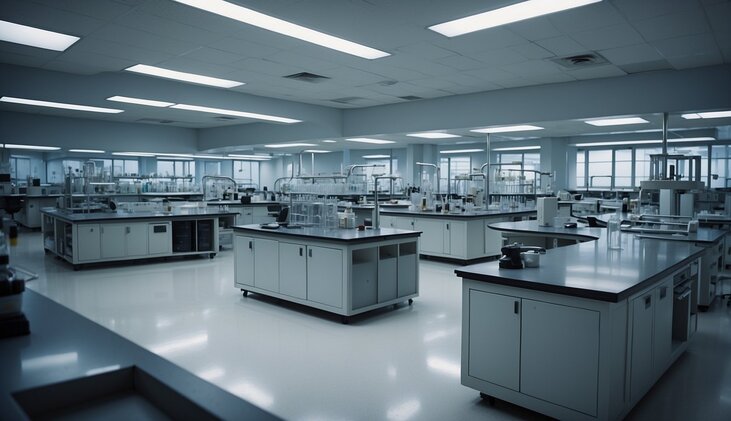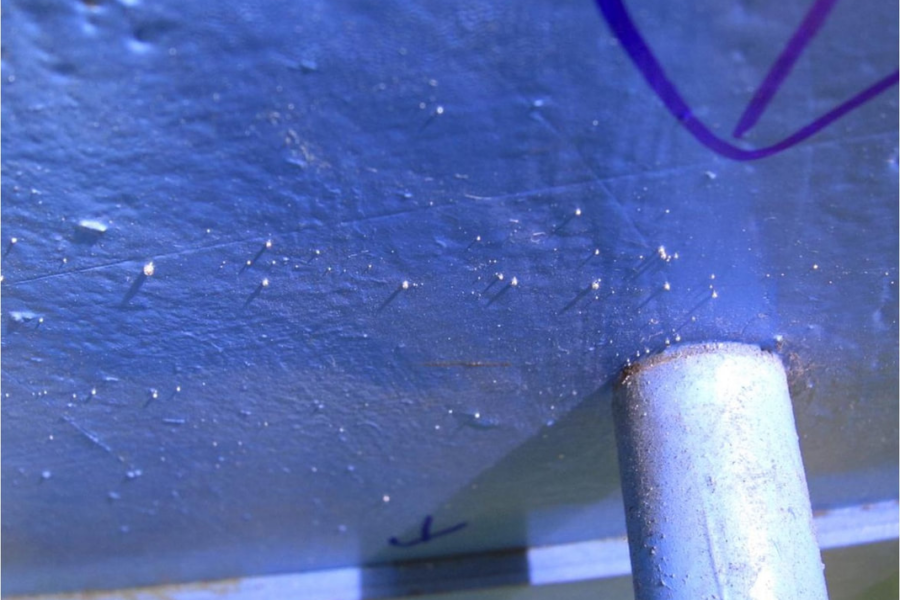Mercury’s impact on the environment raises urgent questions about its management and remediation. Known for its persistence and toxicity, mercury poses significant risks not only to wildlife but also to the broader ecosystems. Key sources include industrial emissions and products like thermometers and light bulbs, often leading to contamination when improperly handled.
At 3D Enviro, our specialized remediation services address these challenges, ensuring safer environments and compliance with stringent regulations. Our expertise in mitigating mercury hazards underpins the essential services we provide to facilities grappling with contamination. In this article, we will explore the varied effects of mercury on wildlife, ecosystems, and human health, emphasizing the critical role of proactive environmental management.
Effects of Mercury on Wildlife and Ecosystems
Bioaccumulation in Food Chains
Mercury’s journey through the food chain, starting from plankton and escalating to top predators like eagles and seals, exemplifies its dangerous bioaccumulation and biomagnification. Studies highlight that this bioavailability leads to severe health issues in wildlife, including behavioral changes, reduced fertility, and increased mortality in birds, along with immune dysfunction and reproductive failures in marine mammals. Notably, research like Virtanen et al. (2021) links these effects to the neurotoxic and oxidative stress properties of methylmercury.
Toxicity to Wildlife Species
Impact of Mercury on Fish
A study by Scheuhammer et al. (2012) shows that even low levels of mercury exposure impair fish neurochemistry and endocrine function, leading to significant biological impairments. These include altered reproductive success and growth rates, which can result in long-term population declines.
Mercury’s Effects on Birds
Birds, from waterfowl to raptors, experience neurological problems and decreased chick survival rates. Research highlighted by Basu et al. (2018) shows that mercury exposure can lead to immunotoxicity and impaired neurobehavioral functions in birds, affecting their ability to forage, reproduce, and survive.
Mercury’s Impact on Mammals
Mercury causes neurological and reproductive issues in marine and terrestrial mammals, such as dolphins and otters. This leads to behavioral changes, can drive population declines, and disrupts ecosystem dynamics.

Even as the river runs low, nature’s resilience shines through.
Ecological Consequences of Mercury Pollution
Finally, it’s clear from the above effects on wildlife, that ecosystems also suffer. Mercury affects both biotic (living organisms) and abiotic (non-living) components. Aquatic ecosystems experience reduced fish populations, impacting the entire food web. Mercury’s toxicity extends beyond aquatic environments, influencing diverse wildlife species and ecosystems.
Mercury’s impact on ecosystem health includes factors that contribute to long-term ecological damage, including:
- Changes in primary productivity
- Altered food web structures
- Disruptions in energy flow
What effects the wildlife ecosystems and the food web will inevitably have an effect on humans. Let’s look at that further now.
Human Exposure and Health Risks
When humans come into contact with mercury, it can lead to serious health problems. People can get exposed to mercury in different ways, with severe impacts on both adults and children. Historical incidents like Minamata Disease show the devastating effects mercury poisoning can have on communities.
“We know that mercury exposure, even at low levels, can cause serious neurological issues, including anxiety, depression, and central nervous system disorders. It’s particularly dangerous for unborn babies and children.” – Lauren Neese Truslow, BS in Environmental Science, CEO at 3D Enviro
From Environmental Contact to Human Intake
Humans can ingest mercury through contaminated water and food, especially fish. Methylmercury is especially dangerous because it bioaccumulates in fish. This means that even small amounts of mercury in the water can become concentrated in fish, making fish consumption a major risk factor.
Pregnant women are particularly vulnerable as methylmercury can cross the placenta, affecting fetal development. Exposure can also happen through inhalation of mercury vapor from industrial sources or broken mercury-containing thermometers.

Health Impact on Adults and Children
Exposure to mercury can harm both adults and children. For adults, it can affect the renal, cardiovascular, and nervous systems. Symptoms can include memory loss, tremors, and insomnia. For children, the risks are even more severe. It can lead to cognitive impairments and developmental delays.
Methylmercury exposure in children can result in attention, language, and memory issues. Chronic exposure, even at low levels, can cause long-lasting damage to the central and peripheral nervous systems.
The World Health Organization further highlights that mercury, particularly methylmercury, is a potent neurodevelopmental toxicant. The following table describes this issue.
|
Exposure Type |
Health Impact |
|
In utero exposure |
Severe outcomes such as cerebral palsy, psychomotor disorder, and other neurocognitive deficits |
|
Prenatal exposure |
Impairment of fetal brain development, affecting motor skills, causing auditory and visual disturbances |
|
Chronic mercury exposure in adults |
Cardiovascular issues, including hypertension and increased risk of heart attack |
|
Occupational exposure in adults |
Abnormal irritability characterized by behavioral changes, and social phobia |
Minamata Disease and Historical Context
Minamata Disease is a clear example of mercury’s detrimental effects. It was first identified in Minamata, Japan, in 1956. The Chisso Corporation’s factory had been dumping methylmercury into Minamata Bay, contaminating the local fish supply.
This contamination led to severe mercury poisoning among the residents. Symptoms included muscle weakness, loss of peripheral vision, and, in severe cases, death. The disease highlighted the importance of industrial regulation and was a wake-up call to the dangers of mercury pollution. This historical context underscores the crucial need for ongoing vigilance and control measures to protect human health.
When it comes to seafood, moderation is key. Focus on eating fish that are low in mercury such as salmon, sardines, and trout. These fish are good sources of protein and omega-3 fatty acids, essential for heart and brain health.
Impacts on Communities and Indigenous Peoples
Mercury contamination significantly affects the health, cultural practices, and economic status of communities and Indigenous peoples. These impacts are profound and multifaceted, touching every aspect of daily life.
Dietary Habits and Cultural Significance
Many Indigenous groups depend heavily on fish and seafood like tuna, marlin, and swordfish as dietary staples. Mercury contamination disrupts these food sources. For example, mercury accumulates in large predatory fish, posing health risks to those consuming them regularly.
In the Amazon basin, methylmercury in fish impacts Munduruku communities, leading to psychological effects.
Cultural Practices
Fishing is more than sustenance; it is central to many cultures’ identities and heritage. Mercury pollution forces communities to change or abandon these traditions. This loss impacts rituals, ceremonies, and collective memory.
In the Arctic, Inuit communities face increased mercury exposure from methylmercury in marine wildlife, essential to their diet. A study by Harvard University highlights that hydroelectric projects like Muskrat Falls can double mercury exposure. This heightens the risks of cardiovascular disease and neurodevelopmental issues, particularly in children and pregnant women.
Economic and Social Ramifications
Mercury contamination devastates communities reliant on fishing for income. Contaminated fish are less marketable, reducing economic stability. Health issues from mercury exposure also increase medical expenses, impacting overall economic well-being.
For artisanal and small-scale gold-ming communities, the consequences are severe, with health impacts documented in a study conducted by Herman Gibb and Keri Grace O’Leary in the “Environmental Health Perspectives” journal.
Food Security
Mercury pollution limits access to safe food. Communities may need costly imports, which might be culturally unsuitable.
Nutritional deficiencies arise when fish, a primary protein source, is replaced by alternative foods. Mercury exposure in the Canadian Arctic affects food security, leading to dietary risks for local populations.

Scenes like these remind us of the importance of ensuring a thriving environment for future generations.
Mercury’s Role in the Environment
Mercury, a naturally occurring element found in the earth’s crust, poses significant environmental and health risks. It spreads and persists through natural processes like volcanic eruptions and the weathering of rocks, as well as through human activities.
Natural Occurrence and Anthropogenic Sources
Natural sources of mercury include the degassing of the earth’s crust and volcanic activity. Human activities such as coal burning, mercury mining, and the production of industrial chemicals intensify environmental mercury levels. Additionally, mercury is present in common products like thermometers and light bulbs, which can become hazardous when not properly disposed of.
Understanding and managing these sources are critical for mitigating mercury’s adverse effects. At 3D Enviro, we specialize in identifying and managing mercury contamination in a range of settings, ensuring that environmental and public health are safeguarded.
Chemical Forms of Mercury
Mercury exists in three main forms: elemental, inorganic, and organic. Each has distinct properties and behaviors:
- Elemental mercury is a liquid at room temperature. It easily transforms into mercury vapor, posing a risk when inhaled.
- Inorganic mercury includes mercurous and mercuric compounds. These are found in batteries and some skin creams.
- Organic mercury, such as methylmercury, is the most dangerous. It forms when mercury enters water bodies and is transformed by bacteria.
“Mercury actually gets converted to a more toxic organomercury by bacteria in those ecosystems.”
– Scott Neese, Ph.D, founder and scientific advisor at 3D Enviro
Methylmercury bioaccumulates in fish, posing risks to predators, including humans. Consumption of contaminated fish can lead to severe health problems.
Understanding the different forms of mercury is crucial for addressing its environmental impacts. This knowledge helps in developing effective strategies for mercury regulation and remediation. Mercury’s persistence and ability to transform into more toxic forms make it a critical environmental concern.
Atmospheric Mercury
Elemental mercury, prevalent in the atmosphere, has a significant lifespan, allowing it to travel extensive distances. As it interacts with other elements in the air, it forms inorganic mercury compounds. These compounds are deposited on the earth’s surface, contaminating both soil and water bodies.
In water, mercury transforms into methylmercury through bacterial methylation, a highly toxic form that accumulates in aquatic life, posing severe risks within aquatic food webs. This deposition and transformation process underlines the widespread impact of mercury on both terrestrial and aquatic environments.
Mercury Emission and Atmospheric Transport
Once released, mercury enters the atmosphere, where it can travel long distances. Primary anthropogenic mercury emissions, such as from coal combustion and industrial processes, greatly exceed natural geogenic sources. This provides a significant contribution to global mercury pollution.
According to Driscoll et al. in a research study conducted in 2013, mercury emissions are largely transported through the atmosphere before being deposited onto land and water bodies.
Global Circulation and Distribution
Airborne mercury can circulate globally before settling down. This makes mercury a transboundary pollutant, affecting regions far from its source. Mercury is primarily emitted as elemental mercury, which has a long atmospheric residence time. This allows it to be transported over vast distances before deposition.
A study by Liu et al. conducted in 2011 emphasizes that the global circulation of mercury results in its deposition in remote areas. These areas include polar regions, demonstrating its transboundary nature.
Mercury in Industry and Consumer Products
Mercury, due to its unique properties, is used in various industries and consumer products. Its presence in these areas can lead to significant environmental harm.
Small-Scale Gold Mining
In the Amazon Basin, artisanal and small-scale gold mining releases large amounts of mercury into rivers. This mercury contaminates fish and affects indigenous communities relying on these waterways for food. Miners use mercury to extract gold by forming a mercury-gold amalgam. When heated, the mercury vaporizes, releasing toxic fumes into the air and leaving gold behind.
This process contributes heavily to mercury pollution. Rivers and soil become contaminated, causing long-term environmental damage. Fish in these waters accumulate mercury in their bodies, which then enters the food chain. Eating these fish exposes humans to mercury poisoning, causing severe health issues.
Dental, Cosmetics, and Pharmaceuticals
Mercury is also found in dental amalgams, cosmetics, and certain pharmaceuticals. Dental amalgams, used for fillings, consist of approximately 50% mercury. Despite regulations, mercury can still release vapor over time, posing health risks to dental patients and professionals.
In cosmetics, mercury is used in skin-lightening creams and soaps. It acts as a preservative and an antiseptic. Still, it can be absorbed through the skin, causing skin disorders and other health problems.
The following table illustrates how mercury is present in various industries and why some indoor spaces can be contaminated with mercury:
|
Category |
Reason |
|
Building Materials and Demolition |
Floors and Walls: Some older buildings may have used mercury-containing materials in construction. |
|
Demolition Projects: Demolition of old buildings can release mercury from hidden sources like pipes, flooring, HVAC vents, and equipment. |
|
|
Improper Disposal: Historical improper disposal of mercury-containing waste can lead to environmental contamination in facilities. |
|
|
Historical Use of Mercury-Containing Equipment |
Thermometers and Barometers: Older laboratories and industrial sites may have used mercury-containing thermometers, barometers, and other instruments. |
|
Electrical Switches and Relays: Mercury was commonly used in electrical switches and relays due to its conductive properties. |
|
|
Research and Laboratory Work |
Chemical Research: Universities and research institutions might have used mercury in various experiments and chemical processes. |
|
Biological Research: Certain biological experiments may have involved mercury compounds. |
|
|
Industrial Processes |
Manufacturing: Industrial plants might have used mercury in manufacturing processes, such as producing chlorine and caustic soda. |
|
Mining: Historical mining operations might have used mercury for gold extraction, leading to contamination. |
|
|
Healthcare and Medical Facilities |
Medical Devices: Hospitals and medical laboratories might have used mercury-containing devices like sphygmomanometers (blood pressure monitors) and dental amalgams. |
|
Medical Testing: Some diagnostic tests and treatments historically involved mercury. |
|
|
Environmental Spills and Accidents |
Spills: Accidental spills of mercury in any of the above settings can lead to contamination requiring professional remediation. |
If you have any suspicions that your indoor space could have been contaminated with mercury from any of these sources, contact us immediately!
Contact Information:
- Name: Lindsay Neese
- Phone: 434-771-0030
- Email: LindsayN@3DEnviro.us
Prevention and Mitigation Strategies
The first step is clear: limit mercury emissions from sources like coal plants and metal smelters. We must set and enforce strict emission standards.
Key Actions:
- Ban or restrict mercury-added products.
- Use international agreements like the Minamata Convention.
- Install pollution control devices such as scrubbers.
Clean Alternatives and Best Practices
Cleaner technologies can replace mercury in many processes. This reduces risk and promotes safer methods.
Actions Include:
- Develop and promote mercury-free alternatives.
- Switch to safer materials in products like batteries and thermometers.
- Improve practices to minimize mercury use in industries.
Remediation and Waste Management
Proper handling of mercury waste is crucial, and effective remediation can restore contaminated areas. Unparalleled environmental consulting, decommissioning, and remediation solutions ensure compliance with key regulatory statutes. Preemptively identifying and mitigating hazards, safeguarding both workers and the environment throughout demolition or construction processes is essential.
Key Steps:
- Ensure safe disposal and recycling of mercury-containing waste.
- Fund and support cleanup projects for contaminated sites.
- Educate the public on safe mercury handling to prevent spills.

Mercury remediation and waste management often begins at construction sites.
What We Do at 3D Enviro
At 3D Enviro, we recognize the vital importance of managing mercury spills to safeguard both human health and the environment. Our extensive suite of services guarantees a safe and thorough cleanup process:
- Hazardous material assessments
- Environmental remediation
- Superior project management
- Additional services
1. Hazardous Material Assessments
Our specialists conduct thorough site assessments before your project begins to identify and mitigate hazardous materials like mercury, lead, and asbestos. This proactive approach helps prevent potential setbacks, keeping your timeline and budget intact. Our assessments in various settings such as laboratories, hospitals, and industrial sites involve detailed surveys and sampling to ensure no contamination goes unnoticed.
2. Environmental Remediation
3D Enviro offers meticulous decontamination and remediation services for mercury spills. Our Phase 3 remediation process includes decontaminating the affected areas, conducting confirmatory sampling, and ensuring the safe removal of all hazardous materials.
We employ advanced techniques and equipment manage waste effectively, minimizing environmental impact and preventing project delays.
3. Superior Project Management
Our full-service project management approach guarantees efficient and safe execution of cleanup projects. We handle everything from initial hazard identification to final clearance testing, ensuring regulatory compliance and delivering cost-effective solutions. By addressing environmental risks early, we help you avoid costly change orders that can derail your budget and schedule.
4. Comprehensive Services
Beyond mercury spill response and remediation, we provide various services, including mold and fungi identification, indoor air quality monitoring, and hazardous material risk assessments. Our end-to-end project management ensures all environmental issues are resolved thoroughly and efficiently, contributing to the smooth execution of your construction and demolition projects.
Contact Us
For expert mercury spill response and cleanup services, contact 3D Enviro:
Contact Information:
- Name: Lindsay Neese
- Phone: 434-771-0030
- Email: LindsayN@3DEnviro.us
We look forward to helping you with your environmental cleanup needs.

Older laboratories pose risks for accidental mercury contamination.
Final Thoughts
Mercury contamination poses serious risks to ecosystems and human health due to its toxicity and persistence. Preventing mercury pollution is crucial, both outdoors and indoors.
In aquatic systems, mercury transforms into methylmercury, which accumulates in fish and affects birds, mammals, and humans through the food chain. Industrial emissions and improper waste disposal exacerbate this problem, necessitating stringent cleanup and preventive measures.
Indoors, mercury exposure from broken thermometers, certain light bulbs, and industrial equipment can pose immediate health hazards if not properly managed. This is where 3D Enviro can help.
Our expert team specializes in identifying hazardous materials, conducting site evaluations, and providing meticulous decontamination and remediation services. Our Phase 3 remediation process ensures safe removal of hazardous materials, while our project management approach guarantees efficient and cost-effective cleanup operations.
For comprehensive mercury spill response and cleanup services, contact 3D Enviro today. Let us help you keep your projects on track and ensure compliance with all environmental regulations.
Frequently Asked Questions
How does mercury pollution impact terrestrial and aquatic ecosystems?
Mercury contaminates soil and water. In aquatic ecosystems, it accumulates in fish and other marine life. This bioaccumulation affects the entire food chain. On land, mercury affects plant and animal health, disrupting natural habitats.
What are the consequences of mercury exposure on wildlife and biodiversity?
Wildlife suffers from mercury poisoning. Birds and mammals that consume contaminated fish or prey experience reproductive failure, neurological damage, and death. Biodiversity declines as species populations dwindle. Ecosystem stability is compromised.
In what ways does mercury contamination affect human health and the environment?
Humans exposed to mercury face severe health risks. It impairs the nervous system, causing cognitive and motor dysfunction. Pregnant women face heightened risks, as mercury affects fetal development. Environmental degradation leads to loss of biodiversity and ecosystem services, impacting food security and clean water supplies.
What are the primary sources contributing to mercury pollution in nature?
Mercury pollution originates from various sources. Industrial processes, like coal combustion and mining, release large amounts of mercury. Improper disposal of products containing mercury also contributes. Natural sources include volcanic eruptions and weathering of rocks.



